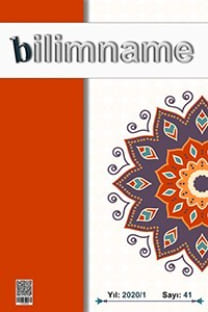RETORİK İMAJIN ANALİZİ VE OKUYUCU ÜZERİNDEKİ ETKİSİNE DAİR BİR İNCELEME
Edebî imge, yaratıcının vizyonunu yansıtan, alıcıyı etkisi altında bırakan ve estetik bir düzene uygun olarak şekillenen sembollerle iç içe geçmiş sanatsal bir ilişkiler ormanıdır. Bu imge örgüsü içerisinde şairin etrafındaki evren, insan ve toplumun problemleriyle ilgili hayalleri, duygu ve fikir atmosferi, kelime dünyası ve görüşleri birbiri ile yoğurulur. Öyle ki bu imge, alıcının aklıyla oynayıp onu aldatabilir, ayrıca onu çeşitli sanatsal görünüşlere ve bu sanatsal görünüşlerin Beyan ilminin de konusunu oluşturan teşbih, istiare ve kinaye gibi kisvelerine bürüyebilir. Bu çalışmanın ele almış olduğu sorun, edebiyat (şiir, nesir, Kur’an-ı Kerîm) eleştirisiyle uğraşan bazı kişilerin retorik imge üzerinde dururlarken, konuyu, eserlerini daha çok öğretim maksatlı tasnif eden es-Sekkâkî, el-Kazvînî ve etTaftâzânî gibi sonraki belagatçıların kitaplarında geçen geleneksel yöntemlerle çözüyor olmalarıdır. Mesela, onlar bir istiare örneğiyle karşılaştıklarında, Beyan ilminin bilinen kurallarını bu örneğe uygular ve onu belagatçıların terminolojisine uygun düşen bir terimle isimlendirirler. Bununla birlikte onlar, bu istiare ile metne ilave edilen güzellikleri göz ardı ederek bu istiarenin siyak içerisindeki konumuyla onu çevreleyen değerleri, fikirleri, musikiyi ve hayalleri görmezden gelirler…
VISION IN ANALYZING THE RHETORICAL FIGURE AND ITS IMPACT ON THE HEARER
The literary image is a forest of symbols and intertwined artistic relations in anaesthetic style that reflects the vision of the creator and influences the recipient.The poet's imagination, passion, ideas, dictionary, the vision for the causes of theuniverse, the human being and the society around him are all meshed in theweave of the image; this image may dance with the mind of the recipient anddeceive him, and adorn him with various artistic shapes. The science ofeloquence studies some of these artistic shapes (metaphor shapes like Tashbeeh,Istia’ra, and Kinnaya). The problem that this research addresses is that if someof the literary critics (poetry, prose, and the Holy Quran) stop at the rhetoricalimages, they analyze them in a traditional school way, and their analysis of thepicture is based on the information found in the later books of the rhetoricscientists like Al-Sakkakkie, Al-Qazwini, and Al-Teftazanni, who categorizedtheir books for educational purposes; In other words, when they see a metaphorin a literature text, for example, they study it in standardized grammatical, as ifit was a mathematical equation, and then give it the appropriate name or termaccording to what came in the terms of rhetoric scientists, yet they ignore the aesthetics added by this metaphor on the text, and do not look at the real artisticvalue of this metaphor; they forget the impact of the context in which thismetaphor is presented, since we know very well that the word itself may changeits connotations according to the context in which it comes...
___
- ISSN: 1304-1878
- Yayın Aralığı: Yılda 2 Sayı
- Başlangıç: 2003
- Yayıncı: -
Sayıdaki Diğer Makaleler
MAKYAVELİZM VE DİNDARLIK: DEMOGRAFİK DEĞİŞKENLER ÜZERİNE AMPİRİK BİR ARAŞTIRMA
GÖÇÜN TRAVMATİK ETKİLERİNİ AZALTMADA SOSYAL DESTEĞİN ROLÜ ÜZERİNE DENEYSEL BİR ARAŞTIRMA
RETORİK İMAJIN ANALİZİ VE OKUYUCU ÜZERİNDEKİ ETKİSİNE DAİR BİR İNCELEME
SİYASALLAŞMA SÜRECİNDE HALKU’L-KUR’AN TARTIŞMALARI
“İBRAHİMÎ DİNLER” KAVRAMSALLAŞTIRMASININ TARİHİ
BİR NESLE MENSUBİYETİN HİKÂYESİ: ANILAR ve DÜŞÜNCELER Celal KIRCA Çamlıca Yayınları, İstanbul, 2018
POST-YAPISALCI LENSLER İLE BİR YAHUDİLİK OKUMASI
ŞARKILARLA DİNÎ VE AHLAKÎ DEĞER AKTARIMI: BARIŞ MANÇO ÖRNEĞİ
